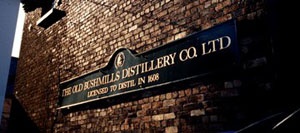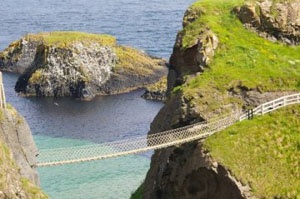History of the Area
The Causeway Coast AONB has a long settlement history and a rich archaeological heritage including many Bronze Age sites such as Clenagh Passage Grave at White Park Bay and Lisanduff Earthworks at Bushfoot. The area has always had close associations with Scotland and this is particularily the case around the Bushmills area. From 300-800AD the Causeway Coast, Rathlin, Glens of Antrim, Islay and Kintyre were part of one sea kingdom known as ‘Dalriada’ and many of the local chieftains such as the McQuillans and McDonnells had important links with Scotland. There has also been a strong Norse influence on the area. Viking raids were common during the ninth century and many of the place names have Norse origin. Most of the other place names have Irish origin like Carrick-a-rede (meaning – the rock in the road) and often shed light on how the area was used in the past.
With such an exposed coastline there have been many shipwrecks including the Girona. Part of the Spanish Armada, the Girona sank in 1588 following a severe storm at Lacada Point with only five of the thirteen hundred men on board surviving. There are also myths and legends associated with the Causeway Coast. One of the most famous tells the story of how the Giant’s Causeway was built as part of a plan by the Irish giant Finn MacCool to challenge his great rival the Scottish giant Benandonner!
A Living Landscape
For those who live and work in the area the Causeway Coast AONB is a ‘living landscape’. Tourism has always been an important industry and many famous travellers have visited the area in the past including Sir Walter Scott, William Thackeray, and Dr Johnson. From 1883 – 1949 a hydroelectric tram service operated from Portrush to the Giant’s Causeway and recently part of this route has been restored for visitors. The Giant’s Causeway and Causeway Coast World Heritage Site is Northern Ireland’s most popular visitor attraction and Bushmills village is home to the famous ‘Old Bushmills Whiskey’ which is exported all over the world. The distillery is an important employer within the area and there are high quality visitor facilities on site.

Fishing is less important today than it was in the past. Fixed net salmon fishing took place at different sites along the coast such as Carrick-a-Rede and the small harbours at Dunseverick and Portballintrae supported many working boats. Today, although some inshore lobster fishing continues, most fishing is recreational. Mining and quarrying was previously important with limestone, iron and aluminium quarried for export to Scotland. Kelp was also collected and the sodium, potassium and iodine extracted used for industry. Farming is characterised mainly by beef and dairy alongside potato and barley production.


